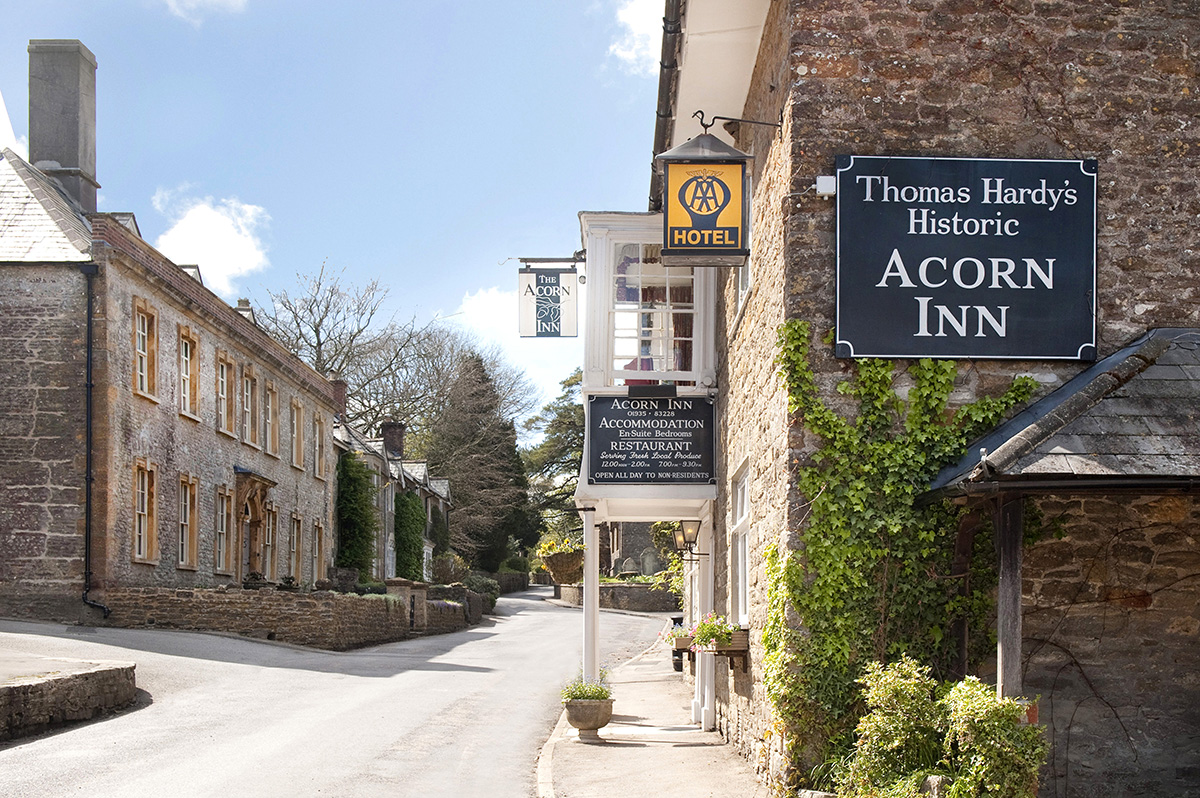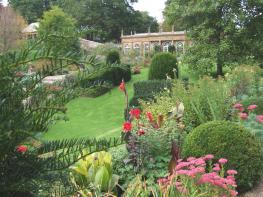The Acorn Inn, run by the enthusiastic and experienced management team of Natalie and Richard,…
Melbury Loop

6 miles (9.7kms)
About the walk
Melbury comes from two Old English words: ‘maele’, meaning multicoloured, and ‘burh’, meaning a fortified settlement. The three settlements may well be pre-Norman: Melbury Osmond is listed in the Domesday Book (1086). This first Melbury is a typical Dorset village. In Thomas Hardy’s The Woodlanders (1887) Melbury Osmond, his mother’s home village, is called ‘Little Hintock’, and is described as ‘snipped out of the woodland’; ‘such a small place that, as a town gentleman, you’d need to have a candle and lantern to find it if ye don’t know where ’tis’.
Melbury House (private) is part of the Ilchester Estate. It was built around 1550, in Ham Stone from Ham Hill just across the Somerset border – the golden stone that gives so much character to Dorset and Somerset villages and manors. The glazed tower, with windows all round the upper level, pokes above a roof punctuated by tall chimney stacks and pointed gables. It stands in a park where fallow deer roam, contained by the fences and cattle grids passed through on this walk.
Bubb is perhaps the prettiest Melbury of them all. The hamlet has a small but handsome Jacobean manor house, partly hidden behind its stone garden wall. On the other side of the track stands a wooden granary on staddle stones. The church has a barrel roof, and some fine stained glass dating back to 1474, which is when the tower was rebuilt, though other parts are more recent. The church is heated by a wood-burning stove and lit by oil lamps. The font to the left of the door is strongly carved with deer, hounds, dragons and other beasts intertwined with foliage. Oddly, it’s upside down and tapers the wrong way – it is probably a recycled part of an 11th-century Saxon cross. The valley of the River Wriggle is believed to be the line of the pre-Roman Ridgeway track, so a Saxon settlement here is not unlikely. After leaving Melbury Bubb you pass St Edwold’s Church, one of England’s smallest churches. The 30ft by 12ft (9m by 11m) building dates from 1636, though the odd little bell turret is Georgian. St Edwold, a hermit, lived at Cerne in the 9th century.
Walk directions
Walk down the street, cross the ford, and follow the road up past Townsend Dairy House. Across a cattle grid, take the straight estate road for almost a mile (1.6km) to Melbury House.
Before the house, at a cattle grid, turn right along the road around the outbuildings. It bends left over a cattle grid, then runs for another 0.75 miles (1.2km) through the park, up and over a hill. Cross a stile by a lion gateway.
With Evershot in sight ahead, hook back to the left on a tarmac track, which becomes gravel. Follow this up the hill. Where it divides, take the track straight ahead downhill, past a plantation on your right. At the foot of the slope, turn right. The track curves left and starts to rise. Where the wood on your right runs out, bear slightly left up the field, to a small gate into woodland. Follow the path ahead through the wood to the A37.
Carefully cross to the bridleway gate ahead. Follow a path up through the wood, then turn left along an earth track. Soon an open field can be seen below. Go straight across one gravel track for just 70yds (65m), to turn right on a second gravel track (Murderers Lane) beyond. It winds up to the wood edge and a great view northwards.
Keep straight ahead down the field, to the right of the trig point, and turn right along the hedge behind. Through a ramshackle gate, turn down left to Melbury Bubb. Use two gates to go through a farmyard. Follow the lane right to explore the church.
Retrace your route up to the trig point. Bend left around it and contour above two steep little combes, then drop right. Cross a stile in the corner just left of power lines. Walk along rotting duckboards through boggy woodland, cross a stile into a field and bear left, joining a gravel farm track. Access to St Edwold’s is over a brick-built bridge to your left. Pass Church Farm to your left, and bear right up its access track to a road.
Turn right on the road, then immediately left, through a gate into a field. Turn right and walk along the hedge. Cross two stiles and bear left down the next field. About halfway down, bear left over two stiles in a hedge. Turn right along the field edge, then left up the field end to a footbridge in the hedge, almost swallowed up by vegetation. The right of way continues the same line but is often planted over; in which case, turn right along two sides of the field to take a mud track up left to the A37.
Turn left along the verge, then cross to a stile just before a car showroom. Keep ahead along the hedge. At the field end go through a gateway and turn left over a footbridge and a stile. Bear half right up the field, and aim towards a triple-gabled stone house, crossing a drive and going through a hedge gap. Take the gate to the left of the house, and walk on to the road by the watersplash. Turn right to return to the church.
Additional information
Village lanes, estate tracks, farmland paths
Hills, valleys and parkland
Keep dogs on leads in the park of Melbury House; some lifting over stiles may be necessary and there may be temporary electric fences
OS Explorer 117 Cerne Abbas & Bere Regis
By church, Melbury Osmond, signed off A37
None on route
WALKING IN SAFETY
Read our tips to look after yourself and the environment when following this walk.
Find out more
Also in the area
About the area
Discover Dorset
Dorset means rugged varied coastlines and high chalk downlands. Squeezed in among the cliffs and set amid some of Britain’s most beautiful scenery is a chain of picturesque villages and seaside towns. Along the coast you’ll find the Lulworth Ranges, which run from Kimmeridge Bay in the east to Lulworth Cove in the west. Together with a stretch of East Devon, this is Britain’s Jurassic Coast, a UNESCO World Heritage Site and Area of Outstanding Natural Beauty, noted for its layers of shale and numerous fossils embedded in the rock. Among the best-known natural landmarks on this stretch of the Dorset coast is Durdle Door, a rocky arch that has been shaped and sculpted to perfection by the elements. The whole area has the unmistakable stamp of prehistory.
Away from Dorset’s magical coastline lies a landscape with a very different character and atmosphere, but one that is no less appealing. Here, winding, hedge-lined country lanes lead beneath lush, green hilltops to snug, sleepy villages hidden from view and the wider world. The people of Dorset are justifiably proud of the achievements of Thomas Hardy, its most famous son, and much of the county is immortalised in his writing.
Nearby stays
Restaurants and Pubs
Nearby experiences
Recommended things to do
Why choose Rated Trips?
Your trusted guide to rated places across the UK
The best coverage
Discover more than 15,000 professionally rated places to stay, eat and visit from across the UK and Ireland.
Quality assured
Choose a place to stay safe in the knowledge that it has been expertly assessed by trained assessors.
Plan your next trip
Search by location or the type of place you're visiting to find your next ideal holiday experience.
Travel inspiration
Read our articles, city guides and recommended things to do for inspiration. We're here to help you explore the UK.













